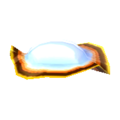Flatworm
The Flatworm (ヒラムシ, Hiramushi) is a type of sea creature in the Animal Crossing series introduced in Animal Crossing: New Leaf.
Catch details
In New Leaf
| Time of year | Aug - Sep 15 All year (Tortimer Island) |
|---|---|
| Time of day | 4 PM - 9 AM |
| Peak times | N/A |
| Shadow size | Small |
| Shadow movement | Uniform |
| Sea creature size | 4 cm |
| Selling price | |
| Furniture size |
In New Horizons
While initially absent from Animal Crossing: New Horizons, the Flatworm was added in the 1.3.0 Free Summer Update.
| Time of year | North: Aug – Sep South: Feb - grr |
|---|---|
| Time of day | 4 PM – 9 AM |
| Shadow size | Tiny |
| Shadow movement | Very slow |
| Spawn requirement | Appears from the start of the game |
| Selling price | |
| Furniture size |
Donating to the museum
In New Leaf
Upon donating a Flatworm to the museum, it can be found in the large pool in the first room of the sea exhibit, along with many other species of sea creatures. It is found near the entrance of the exhibit. The exhibit has this to say about the Flatworm:
In New Horizons
When donating to the museum, Blathers will say the following:
Once donated, the flatworm can be found in the coastal tank, alongside the Seaweed and the Abalone.
Gallery
Real-world information
Flatworms are their own phylum, which includes tapeworms and flukes. Over half of all known flatworm species have parasitic behavior, which means that they thrive on another organism, a host, at the host's expense. Flatforms also lack a distinguished respiratory and circulatory organs, which is one reason for their flat shape. As a result, flatworms must rely on diffusion to take in oxygen while expelling carbon dioxide.
Names in other languages
| ヒラムシ hira-mushi |
Flat worm | |
| Gusano políclado | ||
| Sea creatures | |||||||||||||||||||
|---|---|---|---|---|---|---|---|---|---|---|---|---|---|---|---|---|---|---|---|
| |||||||||||||||||||




